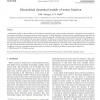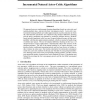181 search results - page 25 / 37 » State Space Reduction For Hierarchical Reinforcement Learnin... |
IJON
2007
13 years 7 months ago
2007
Hierarchical models of motor function are described in which the motor system encodes a hierarchy of dynamical motor primitives. The models are based on continuous attractor neura...
ICAC
2006
IEEE
14 years 1 months ago
2006
IEEE
— Reinforcement Learning (RL) provides a promising new approach to systems performance management that differs radically from standard queuing-theoretic approaches making use of ...
NIPS
2007
13 years 9 months ago
2007
We present four new reinforcement learning algorithms based on actor-critic and natural-gradient ideas, and provide their convergence proofs. Actor-critic reinforcement learning m...
LWA
2007
13 years 9 months ago
2007
Typical conversational recommender systems support interactive strategies that are hard-coded in advance and followed rigidly during a recommendation session. In fact, Reinforceme...
ROBOCUP
2000
Springer
13 years 11 months ago
2000
Springer
Q-learning, a most widely used reinforcement learning method, normally needs well-defined quantized state and action spaces to converge. This makes it difficult to be applied to re...


